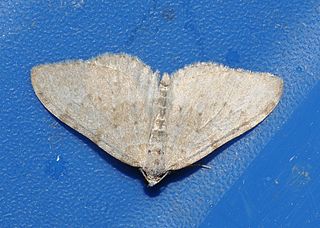Epimydia is a monotypic tiger moth genus in the family Erebidae. Its only species, Epimydia dialampra, can be found in mountainous steppe areas in southern Siberia, eastern Yakutia and northern Mongolia. Both the genus and species were first described by Otto Staudinger in 1892. Females are very small and brachypterous.

Condicinae is a subfamily of moths in the family Noctuidae. The subfamily was erected by Robert W. Poole in 1995.

Victrix is a genus of moths in the family Noctuidae described by Otto Staudinger in 1879. It may be synonymous with the genus Moureia.

Allophyes is a genus of moths of the family Noctuidae. The genus was described by Tams in 1942.

Andicola is a monotypic moth genus of the family Noctuidae. Its only species, Andicola huallatani, is found in Bolivia. Both the genus and species were first described by Staudinger in 1894.
Antha is a genus of moths of the family Noctuidae. The genus was described by Staudinger in 1892.
Aventiola is a monotypic moth genus of the family Erebidae described by Staudinger in 1892. Its only species, Aventiola pusilla, was first described by Arthur Gardiner Butler in 1879. It is found in Japan and south-eastern Siberia.
Bryomoia is a monotypic moth genus of the family Noctuidae. Its only species, Bryomoia melachlora, is found in south-eastern Siberia, Korea, Japan and Taiwan. Both the genus and species were first described by Staudinger in 1892.
Catasema is a monotypic moth genus of the family Noctuidae. Its only species, Catasema vulpina, is found in Uzbekistan. Both the genus and species were first described by Otto Staudinger in 1888.

Dasypolia is a genus of moths of the family Noctuidae. The genus was erected by Achille Guenée in 1852.
Gerbathodes is a genus of moths of the family Noctuidae. The genus was described by Warren in 1911.
Hadjina is a genus of moths of the family Noctuidae. The genus was described by Staudinger in 1891.
Hepatica is a genus of moths of the family Noctuidae. The genus was described by Staudinger in 1892.
Paragona is a genus of moths of the family Erebidae. The genus was described by Staudinger in 1892.
Phidrimana is a monotypic moth genus of the family Noctuidae erected by Vladimir S. Kononenko in 1989. Its only species, Phidrimana amurensis, was first described by Staudinger in 1892. It is found in the southern Urals to Amur.
Stemmaphora is a monotypic moth genus of the family Noctuidae. Its only species, Stemmaphora viola, is found in Turkmenistan, Crimea and Uzbekistan. Both the genus and species were first described by Staudinger in 1888.
Ocnerogyia is a monotypic moth genus in the subfamily Lymantriinae. Its only species, Ocnerogyia amanda, is found in Iran. Both the genus and the species were first described by Staudinger in 1892.
Parocneria is a genus of tussock moths in the family Erebidae. The genus was erected by Harrison Gray Dyar Jr. in 1897.
Dasypteroma is a monotypic moth genus in the family Geometridae. Its only species, Dasypteroma thaumasia, is found in Spain. Both the genus and species were first described by Otto Staudinger in 1892.

Nebula is a genus of moths in the family Geometridae erected by Charles Théophile Bruand d'Uzelle in 1846.





